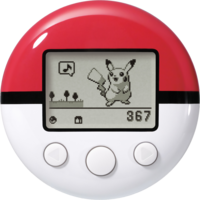Part 97: Side Note #18: Pokewalkin' Around (HGSS)
Side Notes 18: Pokewalkin' Around (HGSS)
We've seen all the cool features we can use with the Pokewalker in the games, but what exactly is this strange pedometer device that tried to make you go outside nearly a decade before Pokemon GO? Well, if you bought HGSS at launch, you probably got one, I've got one (the batteries are dead though) and adds to the remakes's insane resell price online.
As you'd think, you can send a Pokemon to the Pokewalker from the main menu and select from different courses. You can then take that Pokemon for a walk for a walk and for every 20 steps you take, you'll gain a Watt. Now does all sounds familiar? Well that's because it's a successor to the original pedometer released way baack in 1997: The Pokemon Pikachu. That's a weird name. It's a simple walking tool, the more you walk, the more Pikachu likes you and the more activities you can do with it. It's succeeded by the Pokemon Pikachu 2 GS, released in 1999. This one could interact with Gen 2 games and let you send Mystery Gifts over.
In contrast to the Pikachu walkers, the Pokewalker lets you send over any Pokemon. When you gain watts, you can use it on Poke Radar or Dowsing Machine functions. This lets you get items or brand new Pokemon to transfer back into the main game. The Pokemon you find are determined when you send a Pokemon over, so if you want something different, you'll need to resend a Pokemon. There are 27 different courses, with two unlocked to begin with. To get more, you'll need to spend Watts on them to unlock them, up to 100,000. There are also special courses that unlock when you do certain things, such as obtain a foreign Pokemon from the GTS (which you can't do anymore), or transfer a Jirachi to the game (which you also can't do anymore). There are also downloadable courses which, yeah, you can't do anymore. What fun.
With the Dowsing Machine, you're presented with 6 tufts of grass and have to select one. If you don't find anything, the game will tell you if you're near (in an adjacent patch) or far (two or more patches away). It's a 50/50 chance if you really get anything if you follow the clues directly. Each course has different items, but like the Pokemon availability, you'll need to do a certain amount of steps to be able to find these rarer things, varying from 3000 steps on the early courses, to over 10,000 on the later ones. If you send a Pokemon that has an advantageous type to that area you've sent it to, then you'll only need 75% of the steps necessary to find a rarer Pokemon. For example, in the first course, Refreshing Field, you can only find Pidgey and Sentret to begin with, as well as only finding Potions. After 500 steps, you can find both Nidoran. After 2000 steps, Doduo. And after 3000 steps you can get Kangaskhan. But if you have a Fire, Bug or Flying type, it only takes 2250 steps to get it. Items are unaffected by this, so you still need 2500 steps to have a chance of getting Revives. Postgame courses let you find Pokemon not normally found in the game, similar to the Safari Zone.
The special events courses are especially interesting, the Yellow Forest, for example, let's you get many Pikachu that have Volt Tackle, or Surf, or Fly in their movesets. When you catch a Pokemon, everything except their Nature is determined, so they have locked in movesets, gender, level and even held item for certain ones. With enough grinding you can get some really cool stuff from the Pokewalker. Though it does require you taking so many steps. That can be circumvented by just shaking it, or putting it on top of a large vibrating machine, such as a tumble drier. And of course some of these special events were only released in Japan, as is the norm.
Like I mentioned in the last update, you can communicate with other Pokewalkers and receive an item from them depending on the course they're on, with a limit of 10 items. Like with mixing records (man, remember when that was a thing?) you can only communicate with the same person once per day and your in-game team data is sent to them, allowing you to battle opponents in the Trainer House. You can even technically clone Pokemon using the Pokewalker by turning off save data while a Pokemon is being transferred, making a Pokemon be both in-game and in the Pokewalker at the same time. However, if you try to send it back to the original game, it'll be released, as the game recognizes it wasn't caught in the Pokewalker and doesn't match the data of the Pokemon that was sent to the Pokewalker (since it technically never happened).
Despite hardly anyone really making much use of it (I certainly didn't), the Pokewalker has a lot going for it, but it is pretty goddamn grindy. When effectively used, it allows you to obtain Pokemon much earlier than you normally would and gives you a constant supply of items. Plus, if you still have one, along with the game, you could probably sell it for a nice chunk of change.